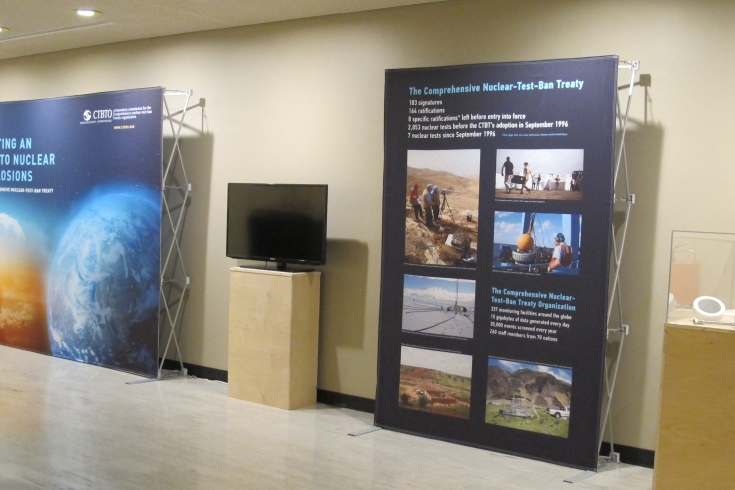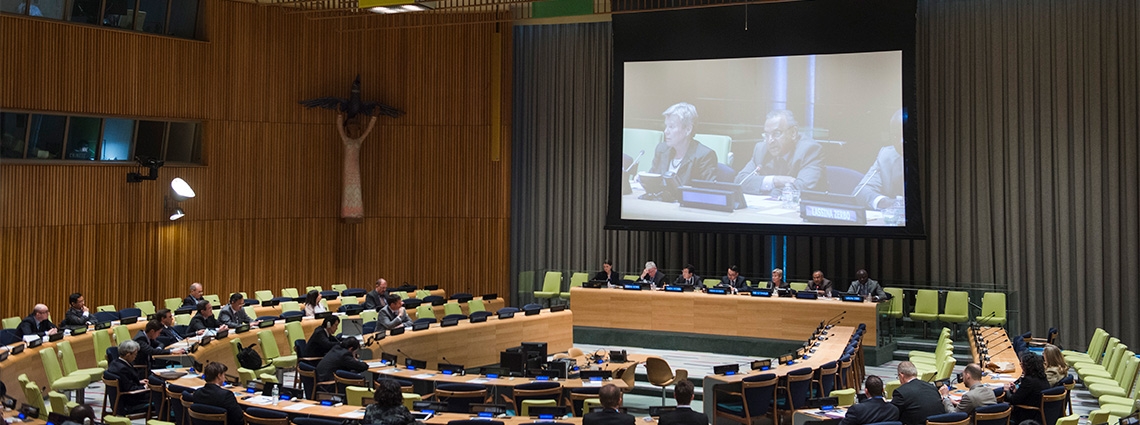The CTBT: a Stepping Stone on the road to a nuclear-weapon-free world
The Comprehensive Nuclear-Test-Ban Treaty (CTBT) is a “stepping stone” for strengthening the Nuclear Non-Proliferation Treaty (NPT) and reinforcing the broader disarmament and non-proliferation regime, Executive Secretary Lassina Zerbo said today at the 2015 NPT Review Conference.
A legally binding test ban represents one key area where all NPT States Parties are already in agreement.
"We must ask ourselves, why is it that we have failed to bring the CTBT into full legal standing? It has been nearly twenty years since the opening for signature, and yet the Treaty is still not in force," Zerbo told delegates assembled at the United Nations headquarters in New York ( full statement
- PDF).
Mere words of support without real action will not suffice. Bringing the CTBT into force is the responsibility of all NPT States Parties. And just as importantly, if action is not taken, you will bear the responsibility for letting the Treaty fail. With your continued support for the Treaty and the full development of its verification regime, I am confident that this outcome will be avoided.
Many delegations at the conference have echoed the call for the CTBT’s entry into force, see compilation of relevant statements. Ambassador Taous Feroukhi of Algeria, President of the 2015 NPT Review Conference, has written an article
(PDF) for the latest version of CTBTO Spectrum on the relationship between the NPT and the CTBT, in which she states that "the NPT and the CTBT are brothers that can only stand strong together."
Instead of a Comprehensive Nuclear Test-Ban Treaty in force or a treaty banning the production of fissile materials for nuclear weapons, we see expensive modernization programmes that will entrench nuclear weapons for decades to come.
A well-attended side event ( flyer
) on the CTBT hosted by Zerbo featured the following international figures: Yerzhan Ashikbayev, Deputy Foreign Minister of Kazakhstan; Rose Gottemoeller, U.S. Under Secretary for Arms Control and International Security; Jayantha Dhanapala, Senior Advisor to the President of Sri Lanka; Takeshi Hikihara, Director-General, Disarmament, Non-Proliferation and Science Department, Japan; and Lord Desmond Browne, Vice Chairman, Nuclear Threat Initiative. During a stimulating discussion, the high-level panel covered the following theme: “Contributing to International Peace and Security in an Increasingly Unstable World: The Urgency of Action on the CTBT”. Dhanapala and Browne are also members of the Group of Eminent Persons, commonly known as the GEM. Watch recording of the side event (due to a technical error, the video starts at 0:16):
During his visit to New York, Zerbo held a number of bilateral meetings with key political figures. The EU High Representative Federica Mogherini reiterated her strong commitment to promoting the CTBT’s entry into force, which she is also pursuing as a member of the CTBTO’s Group of Eminent Persons. Mogherini confirmed her willingness to maintain her membership in the GEM. They also agreed to explore the possibility of the European Union hosting a GEM meeting on the twentieth anniversary of opening up for signatures of the CTBT in 2016, see European Commission's website.
Zerbo also met with the President of the 2015 NPT Review Conference, Ambassador Taous Feroukhi, with the Deputy Foreign Minister of the Republic of Korea, Shin Dong-ik, and with Norway’s State Secretary, Bård Glad Pedersen. On 28 April, Zerbo addressed the media at the UN Spokesperson’s noon briefing:
Illustrating how the monitoring stations operate
The CTBTO has set up an exhibition in the main UN building for the duration of the four-week NPT Review Conference. The exhibition features photos of some of the stations that make up the International Monitoring System – the most sophisticated and expansive multilateral arms control monitoring system ever conceived. For the first time, sensors and other components of the stations are on display in public, including equipment from hydroacoustic station HA03 at Robinson Crusoe Island, Chile, which was destroyed by a tsunami in 2010. In a huge logistical and engineering operation, the station has since been rebuilt and is sending data to the CTBTO’s headquarters in Vienna.

